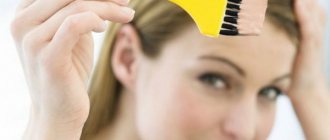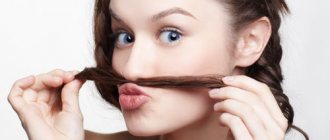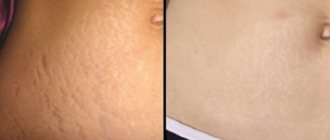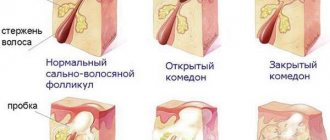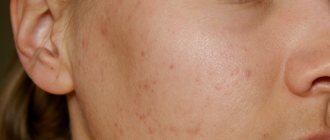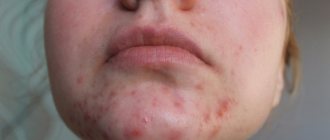Pregnancy and breastfeeding are processes that are regulated by the release of certain hormones in a woman’s body. But the effect of hormones is usually not limited to any one specific function; they almost always have a complex, multifaceted effect on a wide variety of organs and tissues. These include the skin, on which, in some cases, a large number of rashes may appear. We will tell you in this article what to do if after childbirth there is a lot of acne on the face and hands, what are the causes and treatment for this during breastfeeding.
Hormonal fluctuations
There can be various reasons for the appearance of a rash on the body after childbirth, but almost all of them are related to the hormonal activity of the woman’s body. While carrying a child, the pregnant woman's hormone levels were constantly changing. Childbirth causes a powerful hormonal surge, after which new hormonal adjustments occur in the body. They depend on the woman’s health and the course of labor, in addition, on whether the young mother intends to breastfeed.
The appearance of acne on the body after childbirth is provoked by sharp hormonal fluctuations
Immediately after childbirth, the synthesis of the hormone progesterone and human chorionic gonadotropin stops. Such changes can be compared to a diving plane. Throughout pregnancy, the concentration of these hormones steadily increased, reaching maximum values before childbirth. High levels of hormones were necessary to maintain the pregnancy. After the birth of a child, their levels begin to fall rapidly.
Sharp hormonal fluctuations affect the functioning of the entire body. They affect metabolism, water-salt balance, and the functioning of organs and systems. On average, the female body needs about a month for the hormonal levels to stabilize.
During this period, the young mother develops small pimples. They are localized mainly on the chin, forehead and cheeks. However, sometimes acne is found on the legs, arms and stomach. The elements of the rash look like nodules; they do not itch and do not cause discomfort.
In some cases, it may take longer for hormonal levels to stabilize. The body’s ability to recover depends on the woman’s heredity, her health, the severity of the previous birth, the presence of complications and her emotional state. When organ function returns to normal, the rash will disappear without treatment.
When there is danger
It is not so easy to understand why acne appears on the skin, but if you consult an experienced dermatologist in time, it is possible. Very often this problem is a consequence of postpartum hormonal changes.
Read also: When does hair stop falling out after childbirth?
There are times when a girl should be especially attentive and not ignore ambiguous signs. If the rash has an unusual appearance, itches, turns red, is very painful, appears in the form of separate “islands,” festers, or is very large in size, it is forbidden to delay a visit to the hospital. When all this is accompanied by fever, high temperature, weakness, dizziness or poor health, it is important to quickly and promptly call a doctor. This indicates serious complications, infection, allergies or other dangerous diseases.
Prevention measures for this problem have existed for a long time: an active lifestyle, fresh air, clean water, self-care, proper diet.
Pimples during breastfeeding
If a woman does not start breastfeeding, her levels of follicle-stimulating hormone (FSH) and luteinizing hormone (LH) increase. Before birth, their production was suppressed by the pregnancy hormone progesterone. Increasing levels of FSH and LH help improve skin condition, as these hormones stimulate the production of estrogen. Therefore, women who do not breastfeed are less likely to suffer from rashes after childbirth.
The appearance of a rash may be associated with the nature of breastfeeding
If a young mother breastfeeds her newborn, her body begins to intensively produce prolactin. It suppresses the production of FSH and LH and releases male hormones (androgens).
Since the sweat and sebaceous glands are highly sensitive to male hormones, the skin may become covered with pimples. Male hormones make the sebaceous and sweat glands work with triple force. They not only increase the secretion of sebum, but also change its properties.
Sebum becomes thick and loses its bactericidal ability. Under the influence of androgens, the amount of linoleic acid in it decreases. Due to a deficiency of linoleic acid, sebum causes irritation and flaking of the skin. It clogs pores and provokes inflammatory processes. Acne that appears with increased levels of androgens resembles youthful acne. They may look like comedones or ulcers.
The reasons for the appearance of pimples in the postpartum period may be related to the nature of breastfeeding. If a mother applies her baby to the breast with different intensity, the level of hormones in her body becomes unstable. Trying to adapt to a changing feeding regime, the body either reduces or increases the intensity of prolactin production.
This situation usually arises when a woman is about to wean her child from the breast, but cannot decide to do so. Pimples on the chin, cheeks, forehead, as well as on the legs and stomach occur due to hormonal fluctuations.
To maintain a stable concentration of hormones in the blood, it is necessary to reduce the number of feedings gradually. The decision to stop feeding must be irreversible.
How to get rid of acne?
What to do if acne appears after childbirth, how to get rid of it? The use of medications and special medicinal cosmetics is not recommended for nursing mothers, but it is also difficult to come to terms with this unpleasant defect. The best solution is to use natural herbal remedies and maintain good hygiene.
On foot
On the legs, single pimples after childbirth most often appear as a result of hormonal changes or under the influence of external factors - wearing uncomfortable clothes, skin irritation due to heavy sweating in the hot season.
For the purpose of prevention, you should dress according to the season, use linen made from natural, well-ventilated fabrics, such as cotton. During periods of exacerbation of skin problems, you should stop wearing nylon tights and jeans, since clothes that are too tight provoke the appearance of new acne and make it difficult for existing ones to heal.
Salicylic ointment is allowed to be used when breastfeeding. But you need to keep in mind that it dries the skin very much, so it should be applied in small quantities. Taking retinol (vitamin A) also gives good results.
Sometimes rashes on the legs are caused by a staphylococcal infection or a malfunction of the thyroid gland. Therefore, if acne does not go away for a long time, an in-depth examination and selection of appropriate treatment is necessary.
On the back
The appearance of painful acne on the back is a sign of hormonal imbalance, metabolic disorders, poor hygiene or an unbalanced diet. In serious cases, it is difficult to completely get rid of them without the help of a doctor, but you can try to improve the condition on your own.
To do this, you need to thoroughly cleanse your skin every day and wipe it with lotion twice a day. A means for wiping can be a decoction of medicinal plants, a weak solution of potassium permanganate or salicylic alcohol.
Also shown are herbal baths with infusions of chamomile, string, St. John's wort or pine needles. Water procedures with sea salt will also be useful. The effect is achieved after half an hour in a bath with warm broth or saline solution. Before this, you should consult a gynecologist, since after childbirth there may be contraindications to such treatment.
In summer, you can improve your back skin with moderate tanning. The sun's rays dry out the rashes, promoting the rapid disappearance of the rash.
In parallel with the external effects on the skin, it is worthwhile to improve your health from the inside. To do this, you need to exclude foods that are too fatty, spicy, or containing dyes and flavors from your diet, and drink at least 2 liters of purified water per day. In the autumn-spring period, women who have previously experienced acne are recommended to take multivitamins to generally strengthen the body.
On hands
Acne after childbirth on the body, especially in open and visible areas (arms, face), cannot but cause discomfort. The reasons for their appearance are similar to those described above and, if not treated in a timely manner, the inflammatory process can spread further - to the shoulders and back.
For acne on the hands, the problem areas are wiped with herbal decoctions and dried with zinc ointment. To cleanse the skin as quickly as possible, you should not squeeze out pimples; you should also refrain from scratching, since the resulting wounds can become infected.
We recommend reading: Ergoferon during breastfeeding: is it possible for nursing mothers, instructions for use, contraindications during lactation, reviews
When the rash is small and red or looks like a nettle sting, it is most likely caused by an allergy. Typically, such rashes disappear completely after identifying and eliminating the allergen.
What to do if there is a subcutaneous rash?
If subcutaneous acne appears after childbirth, treatment cannot be delayed. This rash varies in color (from flesh-colored to red) and causes severe pain. More often, the pathology is caused by a genetic predisposition or infection, but the presence of a subcutaneous mite (demodex) or a fungal disease is possible. Less commonly, the cause lies in clogged pores.
To rule out serious diseases, you should visit a dermatologist. If the worst options are not confirmed, with the approval of a doctor, it is permissible to do local procedures, such as:
- warm baths with sea salt;
- spot cauterization with iodine;
- rubbing the skin with lemon juice diluted with boiled water (juice of ½ lemon per 200 ml of water);
- treatment of affected areas with ichthyol ointment.
Allergic reactions
If your skin breaks out in pimples after giving birth, they may be a sign of an allergic reaction. Allergies are sometimes caused by painkillers and stimulants used during childbirth.
An allergic reaction may occur after using antibiotics. Antibiotics are mandatory for women who have given birth by cesarean section. They can be used for preventive purposes if delivery was accompanied by tissue rupture requiring complex sutures. Antibiotics are used if a woman is a carrier of the infection. Even drugs used for external treatment can cause an allergic reaction.
Pimples may appear due to an allergic reaction
A woman's tendency to allergies increases after childbirth. Her immune system is weakened by pregnancy and childbirth, especially if it was difficult. Therefore, an allergic reaction can be caused not only by medications, but also by other substances.
A woman in labor may develop acne on her skin after eating allergenic foods.
Allergies can be caused by household chemicals, plant pollen, insect bites, cosmetics, contact with synthetic materials and metal. Women who have previously suffered from allergic reactions of various types are at risk.
An allergic rash looks like a mark from contact with nettles. It consists of individual blisters of different sizes and merging red spots. Unlike rashes of hormonal origin, blisters of an allergic nature are painfully itchy and cause a burning sensation. Symptoms of the disease appear more strongly in the evening.
An allergic reaction negatively affects the functioning of the nervous system. It causes increased irritability, nervousness and sleep disturbances.
Allergic rashes usually first appear on the stomach. In this place, the skin is most vulnerable, as it has been subjected to repeated stretching during pregnancy. Later, the blisters spread to other areas of the body - the face, neck, chest, arms, thighs and buttocks. They disappear after 2-6 weeks, depending on the severity of the allergy. Sometimes a chronic form of the pathology is diagnosed, in which the rash does not disappear for a long time.
Postpartum neuroendocrine syndrome
In some women, after the birth of a child, the process of homeostasis (restoration and stabilization of body functions) is disrupted and the hypothalamic-pituitary-adrenal connections are not normalized.
A feature of women with postpartum neuroendocrine syndrome is rapid weight gain
When childbirth occurs, increased amounts of cortisol, prolactin and testosterone begin to be produced. At the same time, the synthesis of female hormones decreases. Hormonal imbalance is accompanied by varying degrees of hyperglycemia, lipid metabolism disorders, and weakened immunity. A woman may have a tendency to increase blood pressure.
A characteristic feature of women with postpartum neuroendocrine syndrome is a progressive increase in body weight (more than 8 kg). In the area of the abdomen, thighs and buttocks they have flesh-colored or bright pink stretch marks. Hormonal and endocrine disorders make the skin of a young mother oily. She becomes covered with acne. Another sign of postpartum neuroendocrine syndrome is excess hair growth.
Disturbances in the process of homeostasis more often occur in overweight women in labor. Women who have suffered an infectious disease during pregnancy or suffered from severe toxicosis are at risk.
The development of postpartum neuroendocrine syndrome is associated with heredity and existing endocrine diseases. Problems can be caused by difficult labor and bleeding. The main goal of treating pathology is a gradual reduction in body weight. In some cases, diet therapy alone is sufficient to restore homeostasis.
Diseases that cause acne after childbirth
Acne on the face after childbirth sometimes occurs due to weight loss. Although women are usually happy to lose the pounds they gained during pregnancy, weight loss can be a sign of problems in the body.
Features of hyperthyroidism include increased sweating, sleep disturbances, and tremors of the limbs.
A cause for alarm is a weight loss of 10% or more with normal or heavy food consumption in the postpartum period.
A critical decrease in body weight can occur against the background of developing hyperthyroidism. Hyperthyroidism is a condition in which the thyroid gland produces excessive amounts of hormones. Signs of hyperthyroidism include: increased sweating, sleep disturbances, and trembling limbs. Due to hyperthyroidism, the face becomes covered with comedones and pustules.
Losing body weight is sometimes caused by diseases of the digestive tract. If the intestines cannot cope with their function, the number of pathogenic microorganisms in it increases. They release toxins that are absorbed through the intestinal wall and enter the bloodstream, causing a weakened immune system and the appearance of acne on the skin.
Care and prevention
It is very important to keep the leather in good condition at all times, otherwise it will still get dusted from time to time. This can only be done with the help of well-structured care and compliance with preventive measures recommended by cosmetologists:
- minimize the use of perfumes and decorative cosmetics;
- be sure to thoroughly cleanse your face of makeup every evening;
- use delicate cleansers that do not irritate or dry out the skin;
- Under no circumstances should purulent pimples be squeezed out, much less pierced with a needle;
- Make cleansing masks preferably 1-2 times a week;
- provide yourself with enough time for normal rest and sleep;
- try to react to stress as calmly as possible;
- review your diet and include more greens, fresh vegetables and fruits;
- prevent exacerbation of chronic diseases or stop them in a timely manner.
In addition, it is very important to protect your face from the sun and negative environmental influences using high-quality creams.
